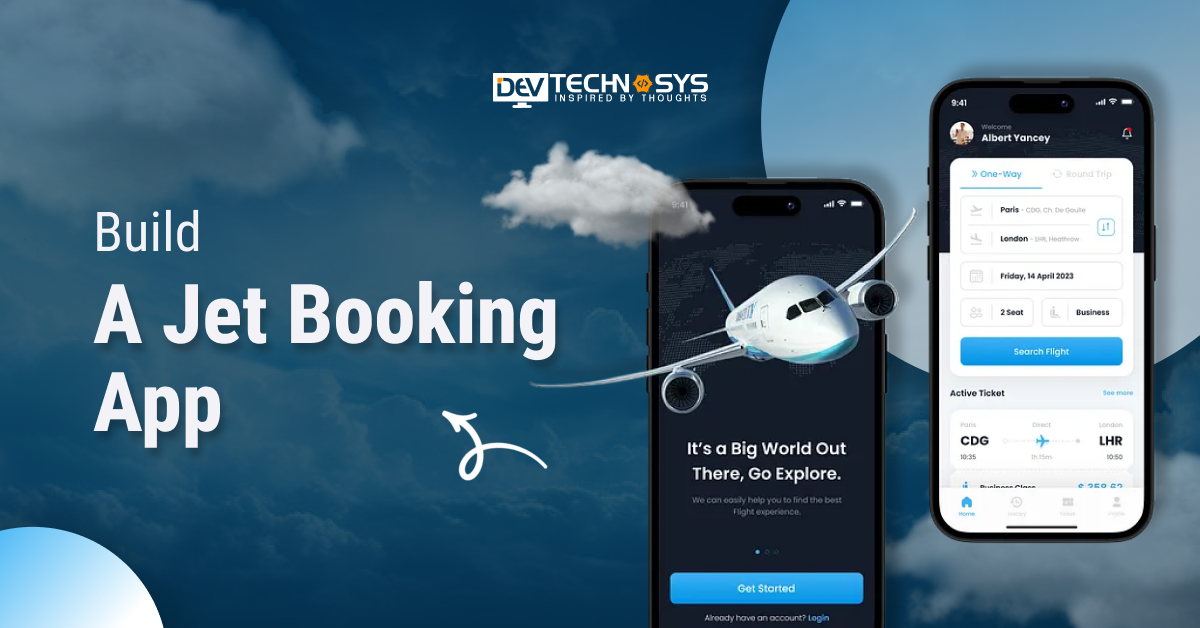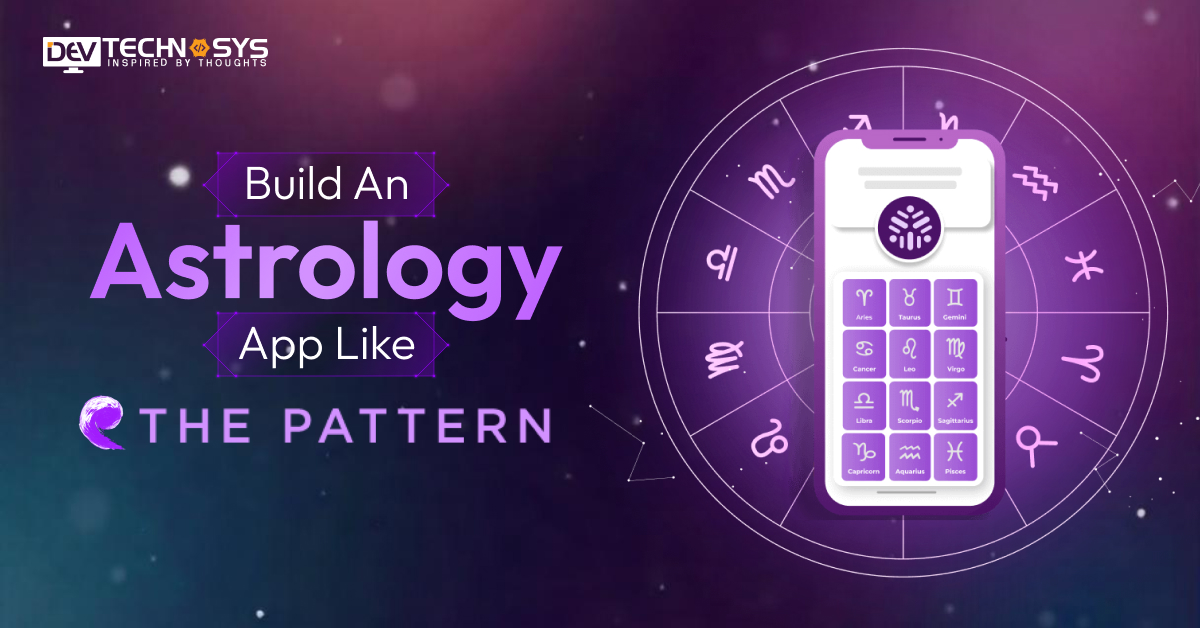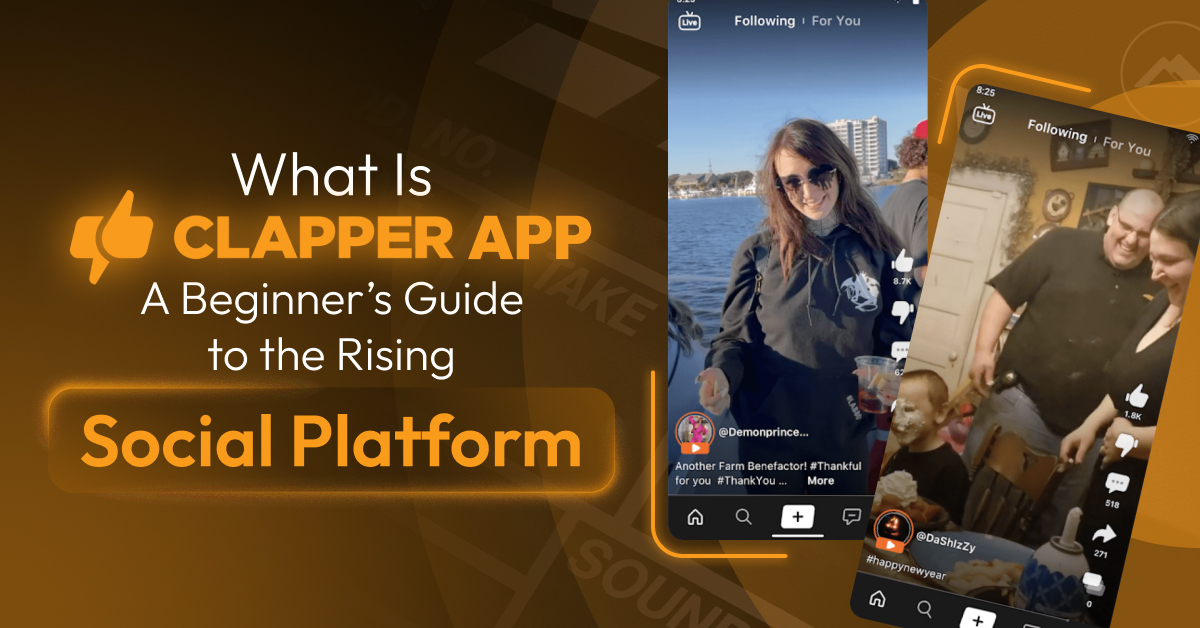As we show, traveling in a jet is a new trend, and the day-by-day number of millionaires is increasing, and they prefer private jets to travel to various continents. Most millionaire entrepreneurs do not want to waste their time on commercial flights; they go for personal jets, which is why the demand for jet booking applications is highly increasing. It allows users to book personal jets and chartered flights with flexible scheduling options.
According to a global study, the aircraft booking applications market was valued at around $1.3 billion in 2023. It is projected to grow around $36.14 billion by the end of 2031.
The above collective data shows that investing in the jet booking app development is a financially rewarding opportunity for entrepreneurs to expand their businesses to the next level.
In this blog, we will explore how to build a jet booking app, premium functionalities, development costs, monetization techniques, and so on.
What is the Jet Booking App?
The jet booking app is an online platform where users can book their private jets at their convenience and schedules, depending on their availability. These aircraft booking applications are mainly for individuals, companies, and groups who want to fly instead of commercial flights.
It allows users to browse different private jets according to budget, destination, and preferences. Private aviation applications include advanced functionalities such as tracking flights, managing booking, booking flights, and comparing prices.
- Real-time jet availability
- Customized flight planning
- Luxury amenities
- Instant price estimates
Market Analysis of Jet Booking Applications
- As per the recent survey, the jet charter apps market is projected to grow at a compound annual growth rate of 1% during the forecast period.
- According to the global report, luxury flight booking apps were valued at around USD 3 billion in 2023.
- In 2031, the private flight booking services market is expected to increase by around USD 14 billion.
- According to research, North America will hold the largest revenue in private jet charter app in 2024.
- With deep knowledge, there are various key players that are operating private air travel apps such as Skyjet, Privatefly, FlyLouie, and Stratajet.
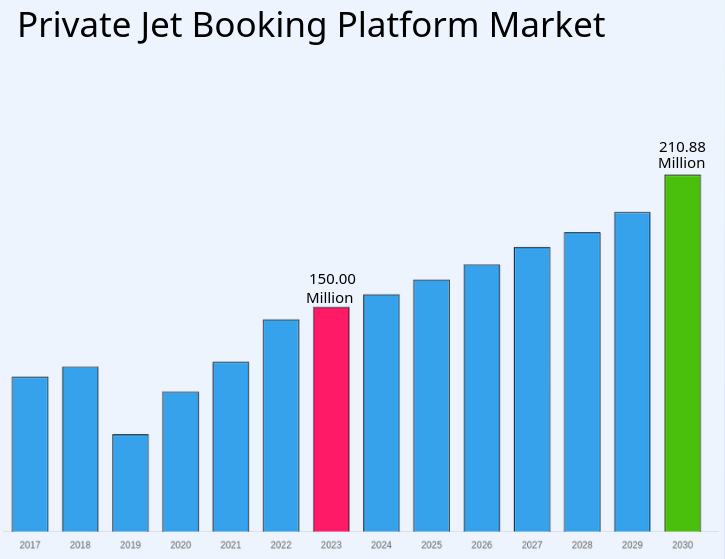
Top 10 Jet Booking Applications
Building private aviation apps without knowing the existing apps’ success rates can be risky. That’s why we provide the best on-demand jet booking platforms with user downloads, ratings, launched year, and platform availability.
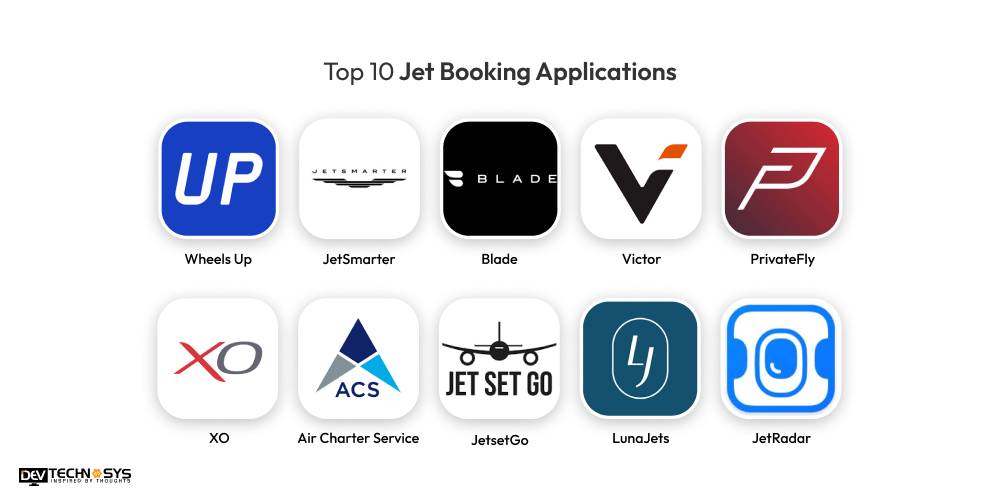
| Applications | Download Users | Stores Ratings | Apps Launched On | Platform Accessibility |
| Wheels Up | 1M+ | 4.6 | 2013 | Android/iOS |
| JetSmarter | 500K+ | 4.3 | 2012 | Android/iOS |
| Blade | 500K+ | 4.5 | 2014 | Android/iOS |
| Victor | 100K+ | 4.7 | 2011 | Android/iOS |
| PrivateFly | 100K+ | 4.5 | 2008 | Android/iOS |
| XO | 100K+ | 4.4 | 2012 | Android/iOS
|
| Air Charter Service | 50K+
|
4.2 | 1990 | Android/iOS |
| JetsetGo | 50K+
|
4.3 | 2014 | Android/iOS |
| LunaJets | 50K+ | 4.6 | 2007 | Android/iOS |
| JetRadar | 10M+ | 4.6 | 2009 | Android/iOS |
Why Do Entrepreneurs Invest in Jet Booking App Development?
With the increasing demand for private jet travel applications, entrepreneurs are ready to develop a jet booking app with unique functionalities to increase their investment return. Here, we provide some of the important reasons why businesses invest in luxury flight booking app development.
- Market Demand
- Convenience and Flexibility
- Globally Reached
- Data Insights
- Monetization Opportunities
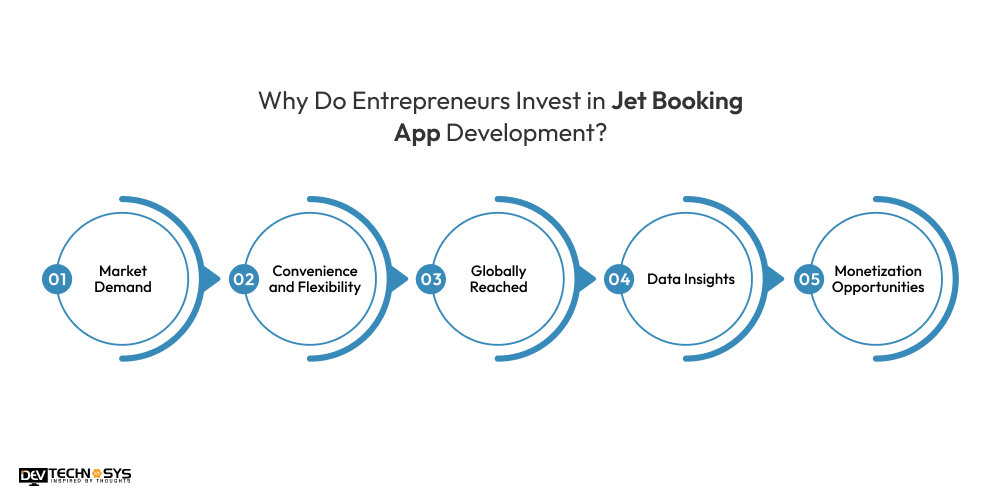
1. Market Demand
The first benefit, as we know, is that private flight reservation applications are in high demand because most millionaire entrepreneurs travel in private jets instead of commercial flights. In case of emergencies and travel for business purposes, they book a private chartered flight for comfortable traveling. So, businesses identify this opportunity to create higher revenue streams.
2. Convenience and Flexibility
The second benefit is luxury flight booking apps offer various advanced functionalities, such as real-time availability, quick flight booking, scheduling, and personalized recommendations, which offer a seamless customer experience. By integrating these functionalities, businesses can also improve the user experience and boost overall sales for long-term success.
3. Globally Reached
Let’s connect to the third benefit: the jet charter app with unique functionality can easily reach globally. With the help of globally reached, the international customer can also access the services of the app from anywhere and anytime. It can enhance the user experience and also increase the overall sales.
4. Data Insights
In the fourth benefit, the aviation reservation platform allows businesses to observe or analyze the user’s daily activities and other useful data insights. This feature analyzes the user’s valuable data, such as purchasing patterns, behaviors, preferences, habits, demographics, most searched, and more. This data helps businesses to identify the areas for improvement and offer new services as per their feedback.
5. Monetization Opportunities
Coming to the last benefit, the private jet reservation app enables businesses to generate revenue opportunities. There are various popular money-making opportunities, such as subscription plans, transaction fees, advertisements, partnerships, in-app purchases, and freemium models. So, these money-making opportunities attract entrepreneurs to invest in them.
7 Basic Steps to Build a Jet Booking App
To create a jet booking app with extensive functionalities, consider the essential steps of development; it clears all the doubts and confusion. It starts from market analysis to post-launch services for successful app development. So, here we provide the robust jet booking mobile app development process:
- Define Requirements and Goals
- Features and Functions
- Select Tech Stacks
- Design UI/UX
- App Development
- Testing and QA
- Launching and Maintenance
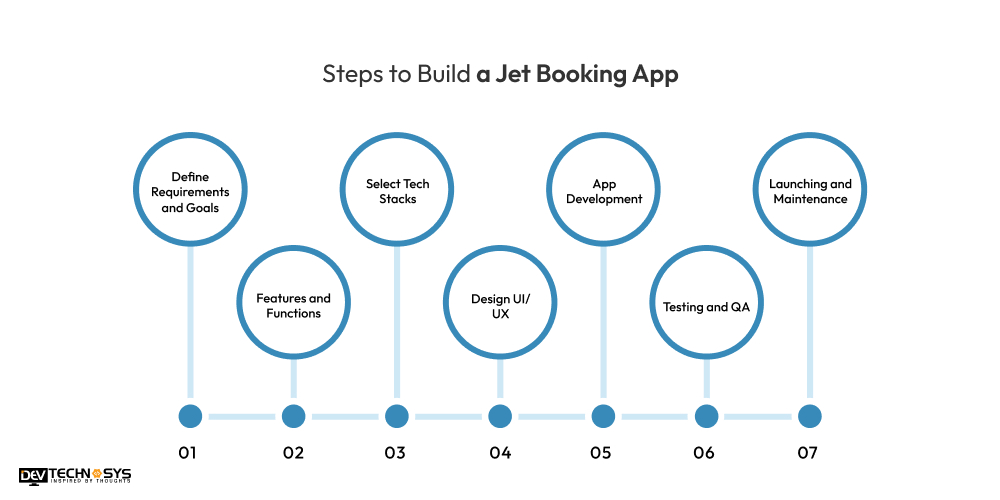
1. Define Requirements and Goals
Let’s begin the robust development process. First, you need to identify the basic and advanced requirements of the project and express your project’s future goals. After that, observe the market demands and which type of mobile applications are highly demanded in this competitive market.
| What are your app’s basic or core requirements? |
| Clear your app’s future goals. |
| Which jet-booking apps are more successful and trending in this competitive market? |
2. Features and Functions
Let’s come to the second stage of development: Hire mobile app developers to identify the core functionalities of your project that you must install. It includes real-time availability, tracking flights, booking flights, account management, and managing flights. You can also analyze the existing app functionalities and find out the useful functions.
| What are your app’s basic or premium features and functions? |
| Observe the existing aircraft booking apps for the best features. |
| Make an organized sheet of features and functions to reduce data redundancy. |
3. Select Tech Stacks
Let’s move to the third stage of development, choosing robust technologies is very important for a successful mobile app development. It includes various tech stacks, such as HTML, CSS, JavaScript(For the front end), Java, Python, PHP (for the back end), MongoDB, MYSQL, SQL(For the Database), and more.
| Which type of tech stacks are used in your private plane reservation app development? |
| Define your scalability requirements. |
| Choose advanced or basic tech stacks. |
4. Design UI/UX
In the fourth stage of development, hire dedicated developers to design a user-centric interface that enables users to easily access all the app’s services. This includes various design resources such as themes, colors, elements, premium templates, layouts, and in-built plugins.
| What are wireframes in UX design? |
| What tools do you use for prototyping? |
| How do you ensure a responsive design? |
5. App Development
Let’s move to the fifth stage of development; you need to assemble a talented development team to integrate third-party integrations, APIs, and other functionalities in backend processes. In this phase, the real coding begins to build the backend services and implement the various features.
| Do you want to create hybrid or native apps? |
| Choose highly talented mobile app developers. |
| Integrate a high number of features and functions. |
6. Testing and QA
In the sixth stage of development, hire an Android app development company to conduct rigorous testing methods to test the airline reservation app. After fixing the bugs and glitches, check the app’s quality and make sure that all the services and functionalities of the app are smoothly working.
| Make sure that all features and functions are working properly |
| Use various testing methods, such as unit and security testing. |
| Check the app’s security measurements. |
7. Launching and Maintenance
Now, the time comes to end the development process. Publish the app on selected platforms, such as Android, iOS, and cross-platform. After it is successfully published, start the maintenance services to update the outdated features, maintain regular ongoing maintenance, and maintain the overall performance.
| Launch your app on selected platforms like Android, iOS, and cross-platform. |
| Use the best marketing techniques. |
| Assign the post-maintenance phases to maintain the app’s performance. |
10 Must-Have Basic and Advanced Features of Private Aviation App
To develop the best charter jet booking platform, you first need to know what features you must add. So, here we provide the simple and premium functionalities of the private airfare booking app:
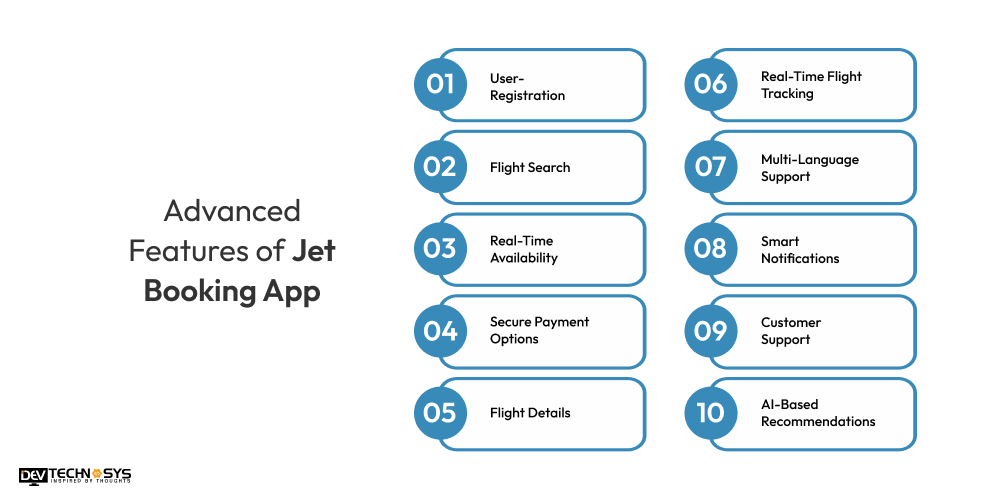
1. User-Registration
The airline booking platform allows users to create an account via mobile numbers, social media platforms, and official email addresses and log in as a guest.
2. Flight Search
A jet reservation system enables users to search the flight by entering the specific time, location, destination, departure, and travel dates.
3. Real-Time Availability
It allows users to check the real-time availability of flights, and it displays the current status of flights and real-time flight updates.
4. Secure Payment Options
The air travel app offers secure online payment options such as credit or debit cards, net banking, and bank transfers to book the flight easily.
5. Flight Details
The aircraft booking app provides detailed information about flights, such as seat selection, boarding time, baggage policy, and more.
6. Real-Time Flight Tracking
The flight reservation app lets users track the flights in real-time, such as flight availability, flight delays, and arrival time.
7. Multi-Language Support
It allows users to set the app’s language according to their flexibility and convenience; it automatically adjusts the language as per the specific location.
8. Smart Notifications
The jet travel platform sends alert messages to users about flight updates, delays, and other new updates available.
9. Customer Support
The aircraft booking app has a support team to manage and handle the customer’s basic queries and solve them as soon as possible.
10. AI-Based Recommendations
AI-based recommendations observe the users’ daily activities and preferences and offer them flight suggestions based on their past flight bookings and more.
The Cost to Develop a Jet Booking App
The cost to create a jet booking app lies between $8,000 to $25,000 or higher based on the specific project requirements. The jet booking mobile app development cost can fluctuate due to crucial factors such as premium features, functions, infrastructure, deployment platforms, size, complexity, and development team. It has additional costs such as testing, designing, networking, maintenance, and more. So, here we provide a detailed explanation of the cost in the table below:
Cost to Build a Jet Booking App
| Jet Booking App Development
|
Estimated Cost | Time Frame |
| Basic App Development
|
$8000 – $13000 | 2 to 5 Months |
| Mid-Premium App Development
|
$14000 – $20000 | 6 to 8 Months |
| High-Premium App Development
|
$25000+ | 9+ Months |
What are the Factors That Affect Jet Booking App Development Cost?
The cost can fluctuate due to crucial factors; businesses need to avoid these factors to create a mobile app in their fixed budget. We offer the factors that have the ability to change the overall development cost. So, let’s take a look at the cost-affecting factors:
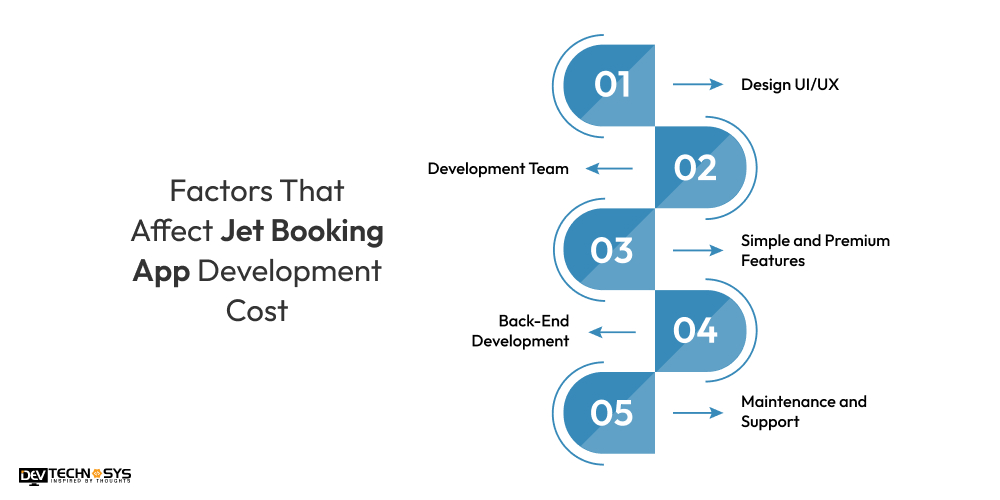
1. Design UI/UX
Let’s start with the first cost-affecting factor; it is one of the most common factors that can easily impact the overall development cost. Simply, if the user wants to design a high-complexity user interface, then they need to use paid themes, templates, and elements. These paid designing resources are highly expensive compared to free designing tools. So, choose the designing tools according to their overall design budget.
| Design Quality | Cost Estimation |
| Basic Design | $8,000 – $12,000 |
| Complex Design | $15,000 – $22,000 |
2. Development Team
In the second cost-affecting factor, the development team is the most crucial factor that has the ability to highly affect the cost of creating a flight booking platform. If businesses want to build a higher complexity private jet rental app, then they need to hire experienced developers with advanced skill sets. However, experienced developers demand higher salary packages as compared to the average experienced developers.
| Developer’s Experience Level | Cost Estimation |
| Entry-Level Developer | $15 – $18/ Per Hour |
| Mid-Level Developer | $18 – $22/ Per Hour |
| Senior-Level Developer | $25+ / Per Hour |
3. Simple and Premium Features
Let’s connect to the third cost-affecting factor: features can be the major concern for businesses, and functions can go for a higher cost. There are premium features such as real-time tracking, AI-based recommendations, multi-language support, and flight details, which can lead to higher costs than the basic functionalities. So, the features should be chosen according to the fixed on-demand app development budget.
| Features | Cost Estimation |
| Core Features(User Registration and Flight Search) | $8,000 – $10,000 |
| Advanced Features(Real-Time Flight Tracking and AI-Based Recommendations) | $13,000 – $19,000 |
4. Back-End Development
The fourth cost-affecting factor is the backend process, which can easily increase the cost of making a flight booking platform. There are various backend processes, such as logic, infrastructure, database, APIs, server-side programming, security, caching, and debugging. So, these highly backed services can affect overall private aviation app development costs.
| Backend Development | Cost Estimation |
| Basic Backend Process | $10,000 – $18,000 |
| Premium Backend Process | $20,000 – $28,000 |
5. Maintenance and Support
Let’s move to the fifth cost-affecting factor: maintenance and support services are also a part of ongoing development, and they can also increase jet booking app development costs. Maintenance includes updating outdated features, fixing bugs and glitches, adding new enhancements, and more. Support services involve managing the basic and complex queries and fixing the problems as soon as possible.
| Maintenance Phase | Cost Estimation |
| Simple Maintenance Phase | $2,000 – $4,000/year |
| Complex Maintenance Phase | $7,000 – $9,000/year |
How to Make Money From Jet Booking App?
The on-demand jet booking software allows businesses to generate higher revenue streams, and it can increase the overall valuation. But most businesses don’t know how to make money from the flight scheduling app. So, here we provide the best money-making technique that can help businesses earn higher revenue stream:
- Subscription Plan
- Commission-Based Model
- Advertising
- Transaction Fees
- Freemium-Model
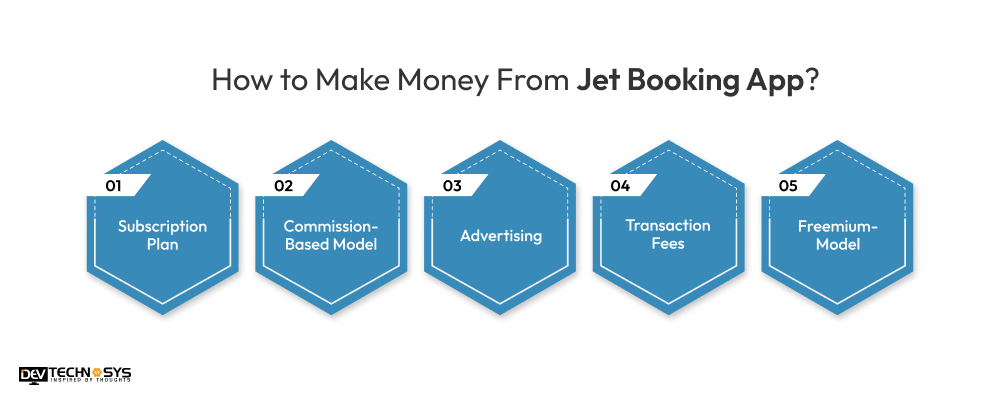
1. Subscription Plan
Let’s start with the first money-making technique: the aircraft booking app offers paid subscription plans such as basic, premium, and enterprise to use the premium functionalities of the app. Users can purchase their plans according to their requirements and demands; these plans purchase monthly, quarterly, and yearly. So it can easily generate new income sources for businesses.
2. Commission-Based Model
Move to the second profit-making opportunity: the private chartered booking app allows third-party businesses to sell their services or products through your app. You can charge a commission of around 10% to 13% of each sale. It is one of the best and most used money-making techniques that can increase a business’s valuation.
3. Advertising
In the third revenue-generating opportunity, the airline reservation app simply displays the advertisements of third-party businesses or agencies. By showing their services and products, you can charge an acceptable fee. So, these small income sources can lead the way to generating higher revenue streams, and they can also enhance the business experience.
4. Transaction Fees
Let’s come to the fourth monetization technique. If users make transactions through your app to purchase subscription plans and additional services, you can charge a transaction fee of around 10% of each transaction. According to the iPhone app development company, this is a simple money-making technique that can also increase transparency between users and businesses.
5. Freemium-Model
Connect to the last money-generating opportunity: the private chartered plane booking app offers a basic version with simple functionalities for newly added users. However, users can not access the premium features if they want to unlock the full potential of the app. They have to purchase the additional features inside the app. So, these additional features can generate new revenue streams and income sources.
Conclusion
At the final stage of this blog, we explored every useful piece of information about how to build a jet booking app and what functionalities must be added. We also offered a cost section that allows businesses to get an idea of the estimated cost of development and what factors can impact the cost.
Investing in the airline reservation app can be a profitable opportunity for businesses, and it provides premium features such as AI-based recommendations, real-time tracking, and smart notifications.
If you want to make a jet booking app, you can connect with our experienced mobile app development company to offer robust development solutions.
Frequently Asked Questions
1. How Much Does It Cost To Build a Jet Booking App?
The cost to make a jet booking app ranges from $8,000 to $25,000 or more, based on the specific demands. It depends on essential factors such as features, functions, size, complexity, infrastructure, development team, and deployment platforms.
2. How Much Time Does It Take To Create a Jet Booking App?
To develop a jet booking app usually takes around 3 to 9 months or more. The timeline is based on the project’s complexity, unique requirements of businesses, developers’ working hours, and project size.
3. What are the Key Features Needed to Build a Successful Jet Booking App?
There are various core features that help businesses and users access all the services with just one tap. Here is the list of features:
- User Registration
- Real-Time Flight Tracking
- Flight Details
- Secure Payment Methods
- Real-Time Flight Availability
4. What Technologies are Needed to Develop a Jet Booking App?
There are robust technologies that are used to create a private chartered booking app, here is the list:
- Java
- Python
- Swift
- Flutter
- Kotlin
- PHP
5. What are the Best Practices for User Experience (UX) in a Jet Booking App?
We offer the best practices for user experience in an aircraft booking app, so here you can observe the list:
- Easy Payment Process
- Intuitive Interface
- Fast Loading Times
- Cross-Device Compatibility
- Clear Communication
